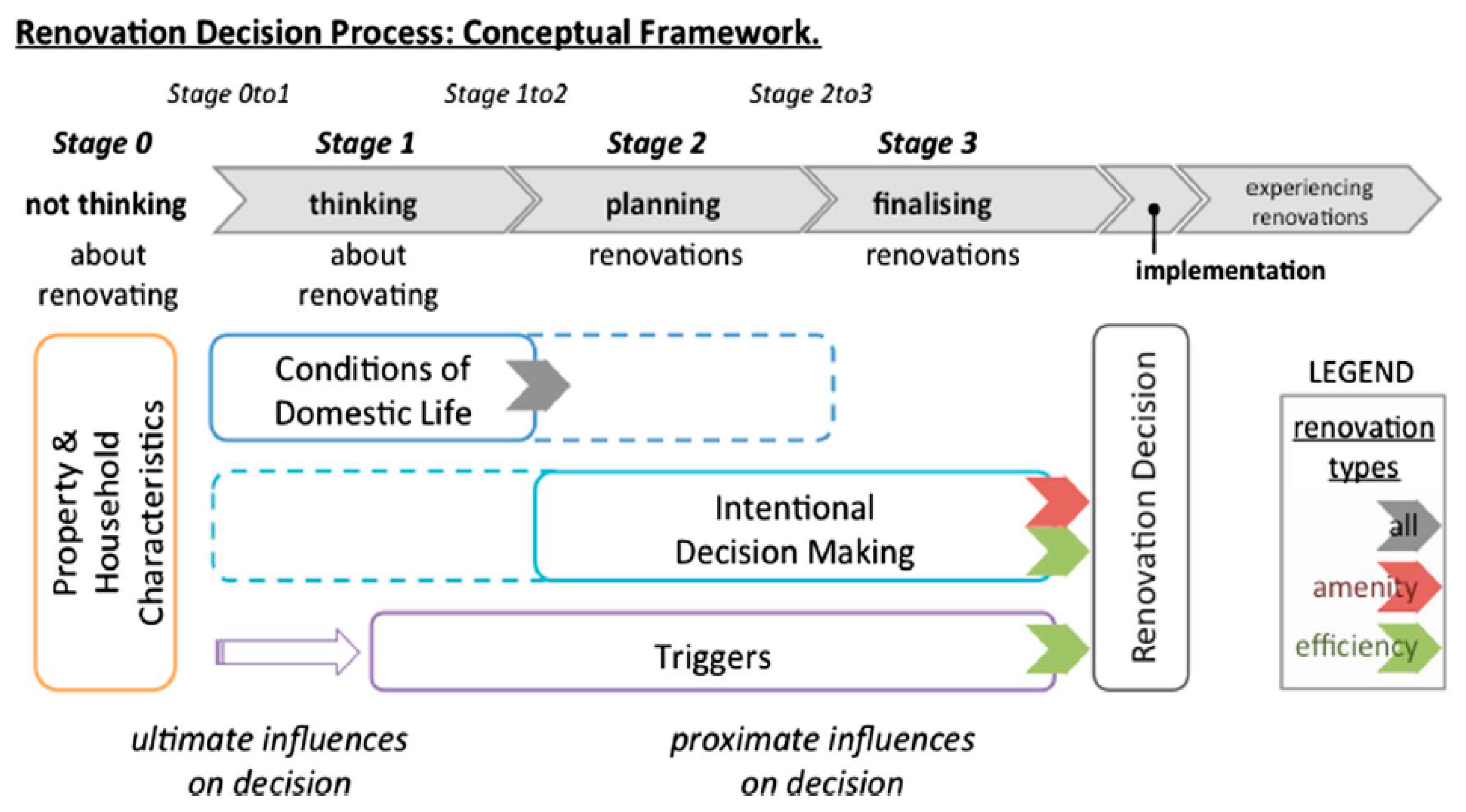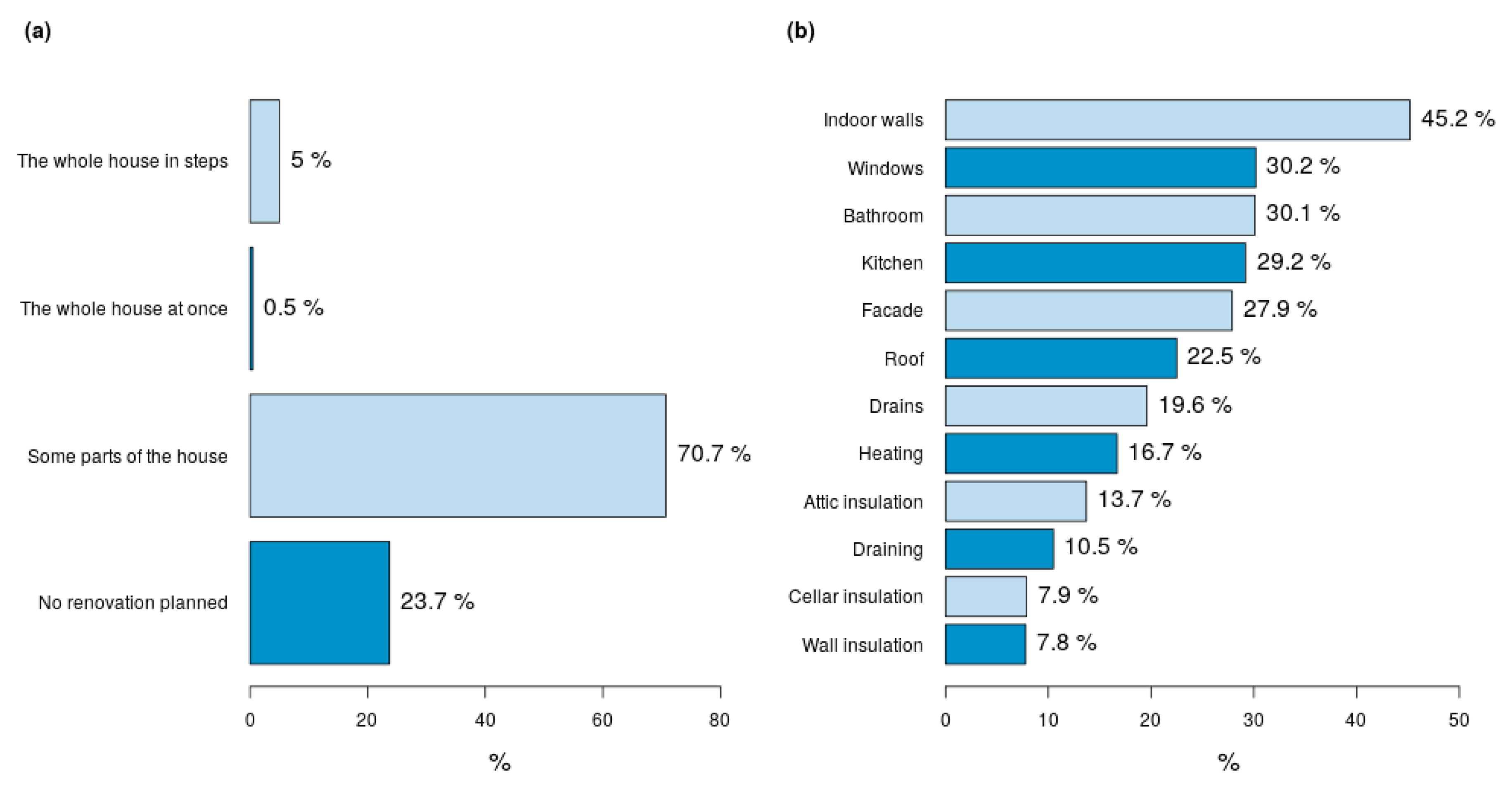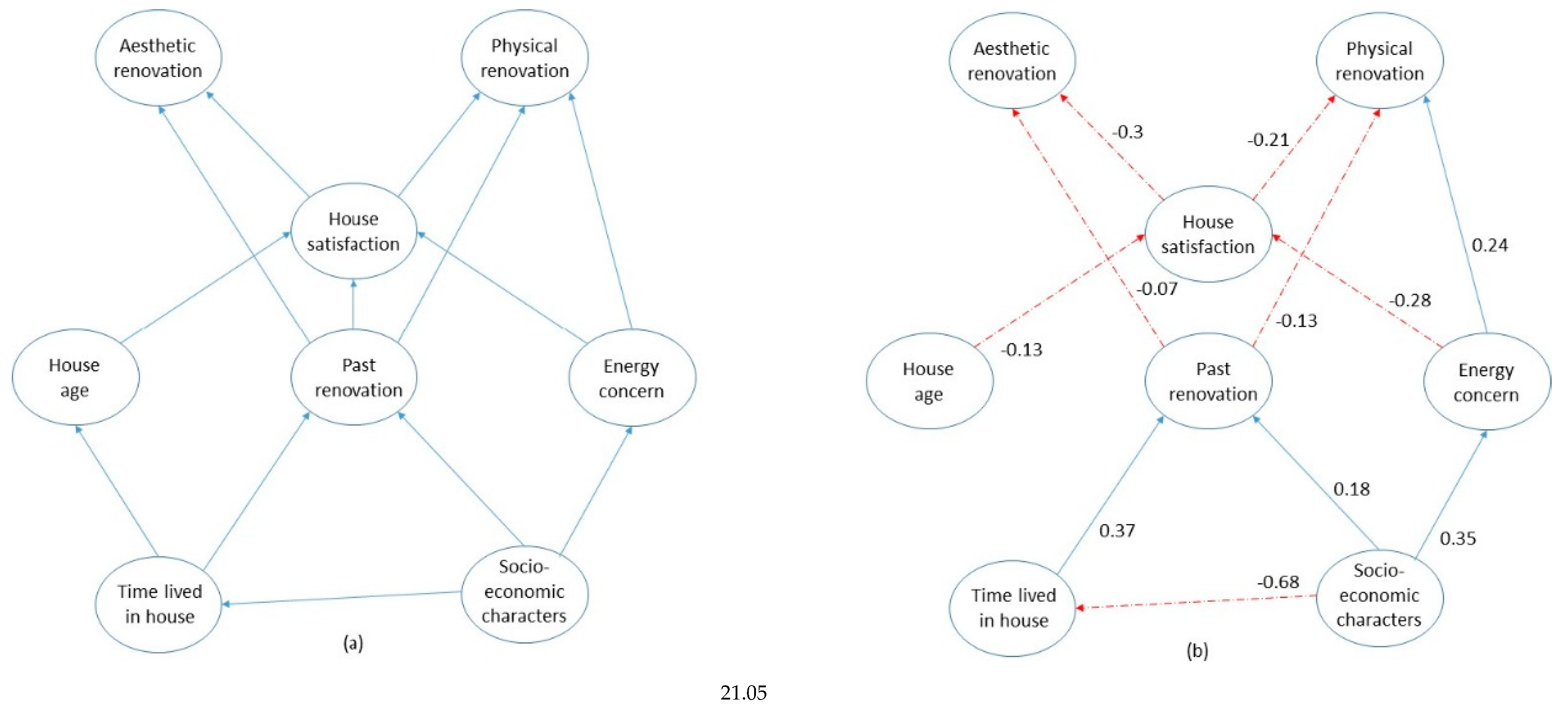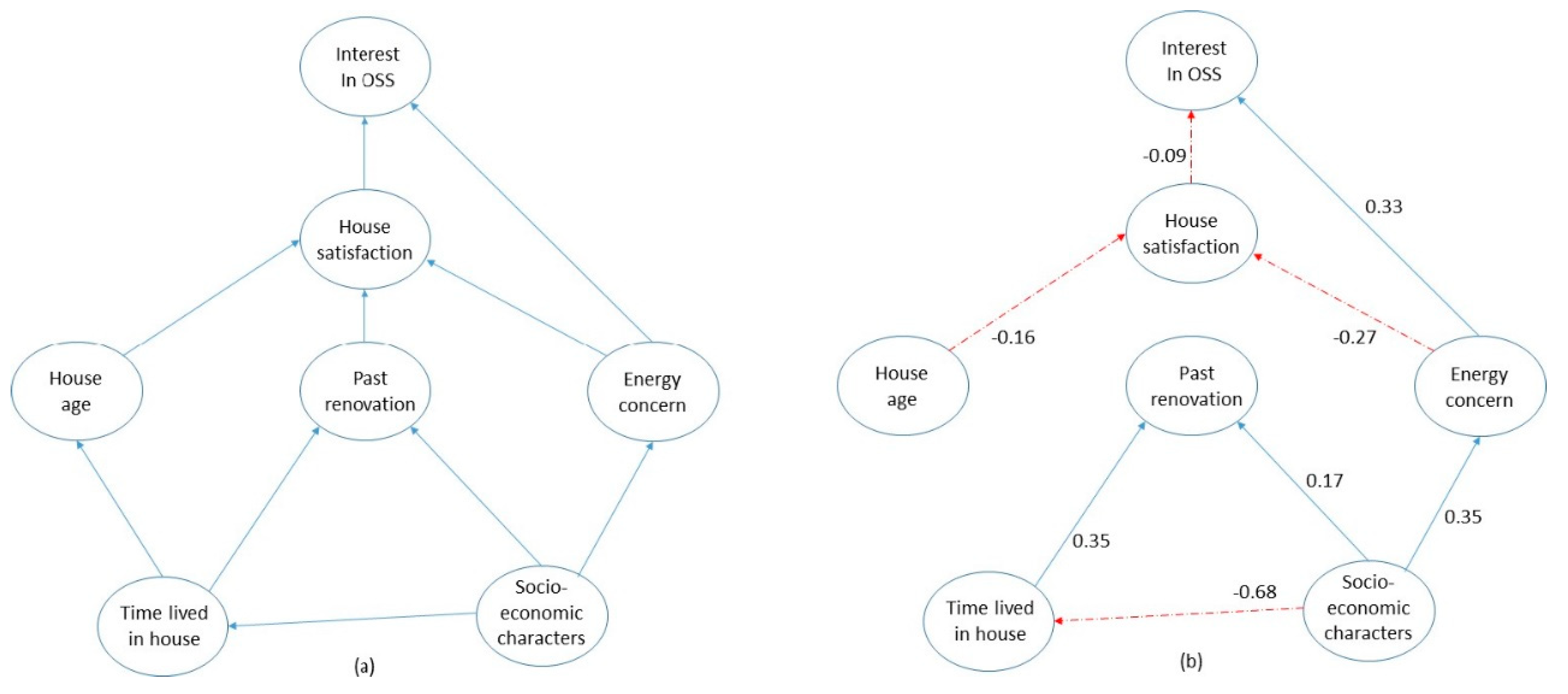Swedish House Owners’ Intentions Towards Renovations: Is there a Market for One-Stop-Shop?
Abstract
1. Introduction
2. Literature Review
2.1. Contexts of Renovation Decisions
2.2. Economic Factors
2.3. Behavioral Factors
2.4. Physical Factors
2.5. Social Factors
3. Methods and Data
4. Presentation of Findings
4.1. Non-Response Bias
4.2. Renovation Plans for the Near Future
4.3. Interest for the One-Stop-Shop (OSS) Concept
5. Discussion and Conclusions
Author Contributions
Funding
Conflicts of Interest
References
- Birol, F. World Energy Outlook Special Report 2013: Redrawing the Energy-Climate Map; IEA: Paris, France, 2013. [Google Scholar]
- Levesque, A.; Pietzcker, R.; Baumstark, L.; Luderer, G. How will buildings’ energy demand look in 2100? Quantifying future energy service demand from buildings. In European Council for an Energy Efficient Economy (ECEEE) Summer Study; ECEEE: Hyeres, France, 2017. [Google Scholar]
- Directive, E.E. Directive 2012/27/EU of the European Parliament and of the Council of 25 October 2012 on energy efficiency, amending Directives 2009/125/EC and 2010/30/EU and repealing Directives 2004/8/EC and 2006/32. Off. J. 2012, L315, 1–56. [Google Scholar]
- European Commission. Directive 2018/844/EU of the European Parliament and of the Council of 30 May 2018 on the energy performance of buildings (amending Directive 2010/31/EU). Off. J. Eur. Union 2018, L156, 75–91. [Google Scholar]
- Energimyndigheten. Renovera Energismart; Energimyndigheten: Eskilstuna, Sweden, 2012. [Google Scholar]
- Swedish Energy Agency. Energy in Sweden: Facts and Figures. 2017. Available online: http://www.energimyndigheten.se/en/facts-and-figures/publications/ (accessed on 16 February 2019).
- Swedish Energy Agency. Summary of Energy Statistics for Dwellings and Non-Residential Premises for 2014 (1654–7543). 2015. Available online: www.energimyndigheten.se (accessed on 11 November 2018).
- Sköldberg, H.; Ryden, B. The Heating Market in Sweden-an Overall View; Sverige Värmemarknad: Stockholm, Sweden, 2014. [Google Scholar]
- SABO. Home for Millions: Conditions for Renovation of the Million-Year-Record-Years’ Housing; KTH: Stockholm, Sweden, 2009. [Google Scholar]
- Stenberg, E. Recycle the Million Program—Individual Solutions for All. In Urbanism: Today’s Urban Construction in Rhetoric and Practice; Nordic Academic Press: Lund, Sweden, 2016. [Google Scholar]
- Elsinga, M.; Lind, H. The effect of EU-legislation on rental systems in Sweden and the Netherlands. Hous. Stud. 2013, 28, 960–970. [Google Scholar] [CrossRef]
- Johansson, P.; Femenías, P.; Thuvander, L.; Wahlgren, P. Pending for renovations: Understanding the conditions of the multi-family housing stock from before 1945. Energy Procedia 2016, 96, 170–179. [Google Scholar] [CrossRef]
- Gustafsson, M. Energy Efficient Renovation Strategies for Swedish and Other European Residential and Office Buildings. Ph.D. Thesis, KTH Royal Institute of Technology, Stockholm, Sweden, 2017. [Google Scholar]
- Gram-Hanssen, K. Existing buildings–Users, renovations and energy policy. Renew. Energy 2014, 61, 136–140. [Google Scholar] [CrossRef]
- Galvin, R. Why German homeowners are reluctant to retrofit. Build. Res. Inf. 2014, 42, 398–408. [Google Scholar] [CrossRef]
- Meijer, F.; Itard, L.; Sunikka-Blank, M. Comparing European residential building stocks: Performance, renovation and policy opportunities. Build. Res. Inf. 2009, 37, 533–551. [Google Scholar] [CrossRef]
- Nair, G. Implementation of Energy Efficiency Measures in Swedish Single-Family Houses. Ph.D. Thesis, Mid Sweden University, Östersund, Sweden, 2012. [Google Scholar]
- Bartiaux, F.; Gram-Hanssen, K.; Fonseca, P.; Ozolina, L.; Christensen, T.H. A practice–theory approach to homeowners’ energy retrofits in four European areas. Build. Res. Inf. 2014, 42, 525–538. [Google Scholar] [CrossRef]
- Galvin, R.; Sunikka-Blank, M. The UK homeowner-retrofitter as an innovator in a socio-technical system. Energy Policy 2014, 74, 655–662. [Google Scholar] [CrossRef]
- World Business Council for Sustainable Development. Energy Efficiency in Buildings. Business Realities and Opportunities; Worls Business Council for Sustainable Development: Geneva, Switzerland, 2010. [Google Scholar]
- World Energy Council. Energy Efficiency: A Recipe for Success; World Energy Council: London, UK, 2010. [Google Scholar]
- Jaffe, A.B.; Stavins, R.N. The energy-efficiency gap What does it mean? Energy Policy 1994, 22, 804–810. [Google Scholar] [CrossRef]
- Sorrell, S.; O’Malley, E.; Schleich, J.; Scott, S. The Economics of Energy Efficiency: Barriers to Cost-Effective Investment. Energy Stud. Rev. 2006, 14, 186. [Google Scholar]
- Reddy, B.S. Barriers and drivers to energy efficiency—A new taxonomical approach. Energy Convers. Manag. 2013, 74, 403–416. [Google Scholar] [CrossRef]
- Haavik, T.; Tommerup, H.M.; Vanhoutteghem, L.; Svendsen, S.; Paiho, S.; Ala-Juusela, M.; Mahapatra, K.; Gustavsson, L.; Aabrekk, S.E. Renovation of single-family houses–an emerging market. In Proceedings of the SB10 Finland Sustainable Building Conference: Sustainable Community-building SMART, Espoo, Finland, 22–24 September 2010. [Google Scholar]
- Mahapatra, K.; Gustavsson, L.; Haavik, T.; Aabrekk, S.; Svendsen, S.; Vanhoutteghem, L.; Paiho, S.; Ala-Juusela, M. Business models for full service energy renovation of single-family houses in Nordic countries. Appl. Energy 2013, 112, 1558–1565. [Google Scholar] [CrossRef]
- Risholt, B.; Berker, T. Success for energy efficient renovation of dwellings—learning from private homeowners. Energy Policy 2013, 61, 1022–1030. [Google Scholar] [CrossRef]
- Bjørneboe, M.G.; Svendsen, S.; Heller, A. Using a One-Stop-Shop Concept to Guide Decisions When Single-Family Houses Are Renovated. J. Archit. Eng. 2017, 23, 05017001. [Google Scholar] [CrossRef]
- Bravo, G.; Pardalis, G.; Mahapatra, K.; Mainali, B. Physical vs. Aesthetic Renovations: Learning from Swedish House Owners. Buildings 2019, 9, 12. [Google Scholar] [CrossRef]
- Baumhof, R.; Decker, T.; Röder, H.; Menrad, K. Which factors determine the extent of house owners’ energy-related refurbishment projects? A Motivation-Opportunity-Ability Approach. Sustain. Cities Soc. 2018, 36, 33–41. [Google Scholar] [CrossRef]
- Achtnicht, M.; Madlener, R. Factors influencing German house owners’ preferences on energy retrofits. Energy Policy 2014, 68, 254–263. [Google Scholar] [CrossRef]
- Abreu, M.I.; Oliveira, R.; Lopes, J. Attitudes and practices of homeowners in the decision-making process for building energy renovation. Procedia Eng. 2017, 172, 52–59. [Google Scholar] [CrossRef]
- Kløckner, C.; Sopha, B.M.; Matthies, E.; Bjørnstad, E. Energy efficiency in Norwegian households-identifying motivators and barriers with a focus group approach. Int. J. Environ. Sustain. Dev. 2013, 12, 396–415. [Google Scholar] [CrossRef]
- Das, R.; Richman, R.; Brown, C. Demographic determinants of Canada households’ adoption of energy efficiency measures: Observations from the Households and Environment Survey, 2013. Energy Effic. 2018, 11, 465–482. [Google Scholar] [CrossRef]
- Bjørneboe, M.G.; Svendsen, S.; Heller, A. Initiatives for the energy renovation of single-family houses in Denmark evaluated on the basis of barriers and motivators. Energy Build. 2018, 167, 347–358. [Google Scholar] [CrossRef]
- Pomianowski, M.; Antonov, Y.I.; Heiselberg, P. Development of energy renovation packages for the Danish residential sector. Energy Procedia 2019, 158, 2847–2852. [Google Scholar] [CrossRef]
- Benigna, Bo.; Paolo, B. One-Stop-Shops for Energy Renovations of Buildings; European Commission: Ispra, Italy, 2018. [Google Scholar]
- Energikontor Sydost. Climate and Energy Strategy for Kronoberg County and the Region of Southern Småland; Energikontor Sydost: Växjö, Sweden, 2010. [Google Scholar]
- Friege, J.; Chappin, E. Modelling decisions on energy-efficient renovations: A review. Renew. Sustain. Energy Rev. 2014, 39, 196–208. [Google Scholar] [CrossRef]
- Jakob, M. The Drivers of and Barriers to Energy Efficiency in Renovation Decisions of Single-Family Home-Owners; Center for Energy Policy and Economics CEPE, Department of Management, Technology and Economics: ETH Zurich, Switzerland, 2007; Available online: http://www.cepe.ethz.ch/publications/workingPapers/CEPE_WP56.pdf (accessed on 29 August 2018).
- Ebrahimi, S.; Qian, Q.K.; Meijer, F.M.; Visscher, H.J. Unravelling Dutch homeowners’ behaviour towards energy efficiency renovations: What drives and hinders their decision-making? Energy Policy 2019, 129, 546–561. [Google Scholar]
- Weiss, J.; Dunkelberg, E.; Vogelpohl, T. Improving policy instruments to better tap into homeowner refurbishment potential: Lessons learned from a case study in Germany. Energy Policy 2012, 44, 406–415. [Google Scholar] [CrossRef]
- Guy, S.; Shove, E. The Sociology of Energy, Buildings and the Environment: Constructing Knowledge, Designing Practice; Routledge: Abingdon, UK, 2014. [Google Scholar]
- Maller, C.J.; Horne, R.E. Living lightly: How does climate change feature in residential home improvements and what are the implications for policy? Urban Policy Res. 2011, 29, 59–72. [Google Scholar] [CrossRef]
- Karvonen, A. Towards systemic domestic retrofit: A social practices approach. Build. Res. Inf. 2013, 41, 563–574. [Google Scholar] [CrossRef]
- Judson, E.P.; Maller, C. Housing renovations and energy efficiency: Insights from homeowners’ practices. Build. Res. Inf. 2014, 42, 501–511. [Google Scholar] [CrossRef]
- Wilson, C.; Pettifor, H.; Chryssochoidis, G. Quantitative modelling of why and how homeowners decide to renovate energy efficiently. Appl. Energy 2018, 212, 1333–1344. [Google Scholar] [CrossRef]
- Gamtessa, S.F. An explanation of residential energy-efficiency retrofit behavior in Canada. Energy Build. 2013, 57, 155–164. [Google Scholar] [CrossRef]
- Alberini, A.; Banfi, S.; Ramseier, C. Energy efficiency investments in the home: Swiss homeowners and expectations about future energy prices. Energy J. 2013, 34, 49–86. [Google Scholar] [CrossRef]
- Banfi, S.; Farsi, M.; Filippini, M.; Jakob, M. Willingness to pay for energy-saving measures in residential buildings. Energy Econ. 2008, 30, 503–516. [Google Scholar] [CrossRef]
- Grösche, P.; Schmidt, C.M.; Vance, C. Identifying free-riding in home renovation programs using revealed preference data. Jahrbücher Natl. Stat. 2013, 233, 600–618. [Google Scholar] [CrossRef][Green Version]
- Palmer, K.; Walls, M.; Gordon, H.; Gerarden, T. Assessing the energy-efficiency information gap: Results from a survey of home energy auditors. Energy Effic. 2013, 6, 271–292. [Google Scholar] [CrossRef]
- Murphy, L.C. 2016. Policy instruments to improve energy performance of existing owner-occupied dwellings. A+ BE| Archit. Built Environ. 2016, 17, 1–242. [Google Scholar]
- Mundaca, T.L.; Mansoz, M.; Neij, L.; Timilsina, G.R. Transaction costs analysis of low-carbon technologies. Clim. Policy 2013, 13, 490–513. [Google Scholar] [CrossRef]
- März, S. Beyond economics—Understanding the decision-making of German small private landlords in terms of energy efficiency investment. Energy Effic. 2018, 11, 1721–1743. [Google Scholar] [CrossRef]
- Friedman, C.; Becker, N.; Erell, E. Retrofitting residential building envelopes for energy efficiency: Motivations of individual homeowners in Israel. J. Environ. Plan. Manag. 2018, 61, 1805–1827. [Google Scholar] [CrossRef]
- Salo, M.; Nissinen, A.; Lilja, R.; Olkanen, E.; O’Neill, M.; Uotinen, M. Tailored advice and services to enhance sustainable household consumption in Finland. J. Clean. Prod. 2016, 121, 200–207. [Google Scholar] [CrossRef]
- Nair, G.; Gustavsson, L.; Mahapatra, K. Factors influencing energy efficiency investments in existing Swedish residential buildings. Energy Policy 2010, 38, 2956–2963. [Google Scholar] [CrossRef]
- Kahneman, D. Maps of bounded rationality: Psychology for behavioral economics. Am. Econ. Rev. 2003, 93, 1449–1475. [Google Scholar] [CrossRef]
- Wilson, C.; Dowlatabadi, H. Models of decision making and residential energy use. Annu. Rev. Environ. Resour. 2007, 32, 169–203. [Google Scholar] [CrossRef]
- Ameli, N.; Brandt, N. Determinants of households’ investment in energy efficiency and renewables: Evidence from the OECD survey on household environmental behaviour and attitudes. Environ. Res. Lett. 2015, 10, 044015. [Google Scholar] [CrossRef]
- Achtnicht, M. Do environmental benefits matter? Evidence from a choice experiment among house owners in Germany. Ecol. Econ. 2011, 70, 2191–2200. [Google Scholar] [CrossRef]
- Earl, P.E.; Peng, T.C. 10 Home improvements. In Handbook on the Economics of Leisure; Edward Elgar Publishing: Cheltenham, UK, 2011; p. 197. [Google Scholar]
- Murphy, L. The influence of energy audits on the energy efficiency investments of private owner-occupied households in the Netherlands. Energy Policy 2014, 65, 398–407. [Google Scholar] [CrossRef]
- Buser, M.; Carlsson, V. What you see is not what you get: Single-family house renovation and energy retrofit seen through the lens of sociomateriality. Constr. Manag. Econ. 2017, 35, 276–287. [Google Scholar] [CrossRef]
- Fan, K.; Qian, Q.K.; Chan, E.H. Transaction Costs (TCs) in Building Regulations and Control for Green Buildings: Case Study of Hong Kong. Creat. Built Environ. New Oppor. 2016, 1, 818. [Google Scholar]
- Hongjuan Wu Qian Queen, K.; Visscher Henk Straub, A. Improving the Supply Chain of Housing Industrialization from Transaction Costs Perspective. In Proceedings of the World Sustainable Built Environment Conference (WSBE17), Hong Kong, 5–7 June 2017; pp. 2792–2797. [Google Scholar]
- Frondel, M.; Vance, C. Heterogeneity in the effect of home energy audits: Theory and evidence. Environ. Resour. Econ. 2013, 55, 407–418. [Google Scholar] [CrossRef]
- Wilson, C.; Crane, L.; Chryssochoidis, G. Why do homeowners renovate energy efficiently? Contrasting perspectives and implications for policy. Energy Res. Soc. Sci. 2015, 7, 12–22. [Google Scholar] [CrossRef]
- Christensen, T.H.; Gram-Hanssen, K.; de Best-Waldhober, M.; Adjei, A. Energy retrofits of Danish homes: Is the Energy Performance Certificate useful? Build. Res. Inf. 2014, 42, 489–500. [Google Scholar] [CrossRef]
- Nauleau, M.L. Free-riding on tax credits for home insulation in France: An econometric assessment using panel data. Energy Econ. 2014, 46, 78–92. [Google Scholar] [CrossRef]
- Baumhof, R.; Decker, T.; Röder, H.; Menrad, K. An expectancy theory approach: What motivates and differentiates German house owners in the context of energy efficient refurbishment measures? Energy Build. 2017, 152, 483–491. [Google Scholar] [CrossRef]
- Zundel, S.; Stieß, I. Beyond profitability of energy-saving measures—Attitudes towards energy saving. J. Consum. Policy 2011, 34, 91–105. [Google Scholar] [CrossRef]
- Parnell, R.; Larsen, O.P. Informing the development of domestic energy efficiency initiatives: An everyday householder-centered framework. Environ. Behav. 2005, 37, 787–807. [Google Scholar] [CrossRef]
- Mlecnik, E.; Cre, J.; Kondratenko, I.; Hilderson, W. Innovations in very low energy retrofit projects. In Proceedings of the PLEA 27th Conference on Passive and Low Energy Architecture, Louvain-la-Neuve, Belgium, 13–15 July 2011; pp. 601–606. [Google Scholar]
- Mahapatra, K.; Gustavsson, L.; Haavik, T.; Aabrekk, S.; Tommerup, H.M.; Svendsen, S.; Paiho, S.; Ala-Juusela, M. Possible Financing Schemes for One-Stop-Shop Service for Sustainable Renovation of Single-Family Houses; Nordic Innovation Centre: Oslo, Norway, 2011. [Google Scholar]
- Baruch, Y.; Holtom, B.C. Survey response rate levels and trends in organizational research. Hum. Relat. 2008, 61, 1139–1160. [Google Scholar] [CrossRef]
- Team, R.C. R: A Language and Environment for Statistical Computing; R Foundation for Statistical Computing: Vienna, Austria, 2018; Available online: https://www.R-project.org/ (accessed on 12 March 2019).
- Esposito Vinzi, V.; Russolillo, G. Partial least squares algorithms and methods. Wiley Interdiscip. Rev. Comput. Stat. 2013, 5, 1–19. [Google Scholar] [CrossRef]
- Lohmöller, J.B. Latent Variable Path Modeling with Partial Least Squares; Springer Science & Business Media: Berlin, Germany, 2013. [Google Scholar]
- Hair, J.F.; Sarstedt, M.; Ringle, C.M.; Mena, J.A. An assessment of the use of partial least squares structural equation modeling in marketing research. J. Acad. Mark. Sci. 2012, 40, 414–433. [Google Scholar] [CrossRef]
- Wong, K.K.K. Partial least squares structural equation modeling (PLS-SEM) techniques using SmartPLS. Mark. Bull. 2013, 24, 1–32. [Google Scholar]
- Sarstedt, M.; Ringle, C.M.; Hair, J.F. Partial least squares structural equation modeling. In Handbook of Market Research; Springer International Publishing: New York, NY, USA, 2017; pp. 1–40. [Google Scholar]
- Do Valle, P.O.; Assaker, G. Using partial least squares structural equation modeling in tourism research: A review of past research and recommendations for future applications. J. Travel Res. 2016, 55, 695–708. [Google Scholar] [CrossRef]
- Xiong, B.; Skitmore, M.; Xia, B. A critical review of structural equation modeling applications in construction research. Autom. Constr. 2015, 49, 59–70. [Google Scholar] [CrossRef]
- Afthanorhan, W.M.A.B.W. A comparison of partial least square structural equation modeling (PLS-SEM) and covariance based structural equation modeling (CB-SEM) for confirmatory factor analysis. Int. J. Eng. Sci. Innov. Technol. 2013, 2, 198–205. [Google Scholar]
- Rogers, E.M. Diffusion of Innovations, 5th ed.; Free Press: New York, NY, USA, 2005. [Google Scholar]




| Age Group (Years) | <29 | 30–39 | 40–49 | 50–59 | 60–69 | 70–79 | >79 | |
|---|---|---|---|---|---|---|---|---|
| Survey | 2.69 | 18.29 | 16.05 | 20.76 | 23.23 | 16.95 | 2.02 | |
| SCB data | 2.45 | 11.61 | 19.14 | 20.83 | 21.05 | 16.90 | 8.03 | |
| Year built | <1940 | 1941–1950 | 1951–1960 | 1961–1970 | 1971–1980 | 1981–1990 | 1991–1900 | >2001 |
| Survey | 19.53 | 6.65 | 6.54 | 17.24 | 29.91 | 10.18 | 3.84 | 6.13 |
| SCB Data | 31.44 | 7.18 | 8.29 | 15.76 | 22.28 | 6.73 | 2.41 | 5.9 |
| Relationships | Direct | Indirect | Total |
|---|---|---|---|
| Socioeconomic characters -> Time lived in | −0.68 | 0.00 | −0.68 |
| house | |||
| Socioeconomic characters -> Energy | 0.35 | 0.00 | 0.35 |
| concern | |||
| Socioeconomic characters -> Past | 0.18 | −0.25 | −0.08 |
| renovation | |||
| Socioeconomic characters -> House age | 0.00 | −0.002 | −0.02 |
| Socioeconomic characters -> House | 0.00 | −0.09 | −0.09 |
| satisfaction | |||
| Socioeconomic characters -> Physical | 0.00 | 0.11 | 0.11 |
| renovation | |||
| Socioeconomic characters -> Aesthetic | 0.00 | 0.03 | 0.03 |
| renovation | |||
| Time lived in house -> Past renovation | 0.37 | 0.00 | 0.37 |
| Time lived in house -> House age | 0.02 | 0.00 | 0.02 |
| Time lived in house -> House satisfaction | 0.00 | −0.01 | −0.01 |
| Time lived in house -> Physical renovation | 0.00 | −0.04 | −0.04 |
| Time lived in house -> Aesthetic | 0.00 | −0.02 | −0.02 |
| renovation | |||
| Energy concern -> House satisfaction | −0.28 | 0.00 | −0.28 |
| Energy concern -> Physical renovation | 0.24 | 0.06 | 0.29 |
| Energy concern -> Aesthetic renovation | 0.00 | 0.08 | 0.08 |
| Past renovation -> House satisfaction | −0.03 | 0.00 | −0.03 |
| Past renovation -> Physical renovation | −0.13 | 0.01 | −0.12 |
| Past renovation -> Aesthetic renovation | −0.07 | 0.01 | −0.07 |
| House age -> House satisfaction | −0.13 | 0.00 | −0.13 |
| House age -> Physical renovation | 0.00 | 0.03 | 0.03 |
| House age -> Comfort renovation | 0.00 | 0.04 | 0.04 |
| House satisfaction -> Physical renovation | −0.21 | 0.00 | −0.21 |
| House satisfaction -> Comfort renovation | −0.30 | 0.00 | −0.30 |
| Age (years) | <30 | 30–50 | 50–70 | >70 | |
|---|---|---|---|---|---|
| 4.5 | 47.7 | 36.4 | 11.4 | ||
| Education | Primary school | High school | University | Other | |
| 8.3 | 35.2 | 55.4 | 1.0 | ||
| Household income | <300K SEK | 300K–400K SEK | 400K–600K SEK | 600K–750K SEK | >750K SEK |
| 9.4 | 15.7 | 23.0 | 22.5 | 29.3 |
| Relationships | Direct | Indirect | Total |
|---|---|---|---|
| Socioeconomic character. -> Time lived | −0.68 | 0.00 | −0.68 |
| in house | |||
| Socioeconomic characters -> Energy | 0.35 | 0.00 | 0.35 |
| concern | |||
| Socioeconomic characters -> Past | 0.17 | −0.24 | −0.07 |
| renovation | |||
| Socioeconomic characters -> House age | 0.00 | −0.01 | −0.01 |
| Socioeconomic characters -> House | 0.00 | −0.09 | −0.09 |
| satisfaction | |||
| Socioeconomics characters. -> Interest in | 0.00 | 0.12 | 0.12 |
| OSS | |||
| Time lived in house -> Past renovation | 0.35 | 0.00 | 0.35 |
| Time lived in house -> House age | 0.02 | 0.00 | 0.02 |
| Time lived in house -> House satisfaction | 0.00 | −0.01 | −0.01 |
| Energy concern -> House satisfaction | −0.27 | 0.00 | −0.27 |
| Energy concern -> Interest in OSS | 0.33 | 0.02 | 0.35 |
| Past renovation -> House satisfaction | −0.02 | 0.00 | −0.02 |
| House age -> House satisfaction | −0.16 | 0.00 | −0.16 |
| House age -> Interest in OSS | 0.00 | 0.01 | 0.01 |
| House satisfaction -> Interest in OS | −0.09 | 0.00 | −0.09 |
© 2019 by the authors. Licensee MDPI, Basel, Switzerland. This article is an open access article distributed under the terms and conditions of the Creative Commons Attribution (CC BY) license (http://creativecommons.org/licenses/by/4.0/).
Share and Cite
Pardalis, G.; Mahapatra, K.; Bravo, G.; Mainali, B. Swedish House Owners’ Intentions Towards Renovations: Is there a Market for One-Stop-Shop? Buildings 2019, 9, 164. https://doi.org/10.3390/buildings9070164
Pardalis G, Mahapatra K, Bravo G, Mainali B. Swedish House Owners’ Intentions Towards Renovations: Is there a Market for One-Stop-Shop? Buildings. 2019; 9(7):164. https://doi.org/10.3390/buildings9070164
Chicago/Turabian StylePardalis, Georgios, Krushna Mahapatra, Giangiacomo Bravo, and Brijesh Mainali. 2019. "Swedish House Owners’ Intentions Towards Renovations: Is there a Market for One-Stop-Shop?" Buildings 9, no. 7: 164. https://doi.org/10.3390/buildings9070164
APA StylePardalis, G., Mahapatra, K., Bravo, G., & Mainali, B. (2019). Swedish House Owners’ Intentions Towards Renovations: Is there a Market for One-Stop-Shop? Buildings, 9(7), 164. https://doi.org/10.3390/buildings9070164







